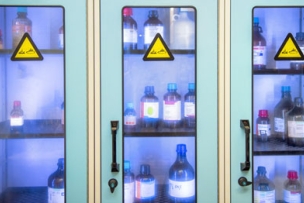Regulations for Flammable Liquids and Gases
The primary source for regulation of flammable liquids in the United States is the National Fire Protection Association’s Flammable and Combustible Liquids Code (NFPA 30). “Their document is the bible for flammables and combustibles,” Brousseau says.
Many companies that have international facilities follow the International Fire Code, whose regulations are similar. “Between the NFPA 30 and the IFC codes, you pretty much have it covered how you’re supposed to be doing stuff with flammable liquids,” he says.
When you’ve determined which guide to follow, “I recommend buying a copy and becoming familiar with it,” he adds. “For any questions you have, contact your local jurisdiction having authority.”
Read more: PPE Assessment Plan: Selecting the Best Type for Your Business
Your local jurisdiction having authority is most likely your local fire department, which will have the final say in how your facility complies with flammable liquids regulations.
“As a former firefighter,” Brousseau says, “I can tell you that their mindset is to help people, not to just issue citations. They will be glad to tell you, ‘This is what you’ve got to do to be compliant.’”
OSHA and NFPA Requirements
The Occupational Safety and Health Administration (OSHA) does not design rules and regulations for flammable liquids, Brousseau notes. Rather, it bases its standards on authoritative agencies such as the NFPA.
Beyond the authoritative agencies, it’s a good idea to consult your insurance provider for any requirements it may have that are different from the NFPA, the IFC or the fire department. Failure to comply with your insurance company’s regulations could affect your insurability.
Different Types of Fire Safety Products for Flammable Chemicals
Given the looming danger of fire risk in manufacturing, safety products for storing, transferring and using flammable liquids are designed to meet exacting standards. Here are a few you might need at your facility:
Flammable liquid storage cabinets are required for any facility storing more than 25 gallons of flammable chemicals, such as solvents. These specially designed cabinets are certified by Underwriters Laboratories (UL) or Factory Mutual (FM), or both. “Almost all facilities will have a need for at least one flammable liquid storage cabinet,” Brousseau says. “They can’t just be metal cabinets that they used to keep their copy paper in.”
Compressed gas cages are needed for facilities that use compressed gases, such as acetylene. Not to be confused with flammable liquids storage lockers, which have a sump for liquids at the bottom, cages are well-ventilated to let the gas safely dissipate.
Safety dispensing cans are good for transferring flammables from a large container (such as a drum) to smaller ones for use around the facility. “They burp and vent off gas when pressure builds up, which is what you want,” Brousseau explains. “They have very tight-sealing lids. They’re a certain thickness.”
Grounding and bonding equipment is required to minimize static electricity sparks that could ignite a flammable liquid while it’s being transferred from one container to another.
Plunger cans are useful for cleaning parts while keeping solvents contained. “You can’t just be dipping your rag in an open container,” Brousseau says. “You have to have the proper designed can, where you plunge down the rag and it gives you just enough solvent to do your job without releasing a lot of fumes.”
Drum faucets have an auto-shutoff feature that prevents liquid from continuing to pour if a worker suddenly isn’t able to stop the flow. “We’ve seen people have strokes or heart attacks, or pass out or trip,” he says, “and by the time it takes to get that person on his feet, you have literally gallons of flammables pouring out all over.”
Frequently Asked Questions About Flammability Limits
What’s the difference between flashpoint and flammability limit?
Flashpoint and flammability limit both relate to the flammability of a chemical substance but refer to different qualities. Flashpoint is the lowest temperature at which a substance will release enough vapors to catch fire with an ignition source. Flammability limit is the percentage range of a substance’s vapor or gas concentration in the air that can catch fire with an ignition source.
How do you reduce explosion risk from flammable vapors?
To reduce the explosion risk from flammable vapors, you need to keep flammable substances away from ignition sources by storing and handling them properly, and by complying with required maximum allowable quantities. Because flammable vapors also need oxygen to ignite, ensure the work area has proper ventilation.
What questions do you have for managing flammable liquids and gases at your facility? Let us know in the comments.





Talk to Us!
Leave a reply
Your email address will not be published. Required fields are marked *